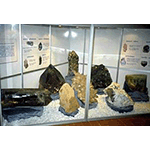Museo di Storia Naturale di Firenze - Sezione di Mineralogia e Litologia [Florence Museum of Natural History - Mineralogy Section]
A first section of mineralogy and geology was set up in the Museum of Physics and Natural History, when Grand Duke Peter Leopold donated to the Museum in Via Romana minerals, rocks, gemstones and carved stones, collected by the Medici family since the first half of the 16th century. In 1878 the Mineralogy and Geology Section of the Museum was moved to its present location, where the Museum and Laboratory of Mineralogy was established in 1880. The numerical consistency of the specimens (around 50,000) and the high scientific and historical value of the collections make it one of the most important museums in the international sphere. It contains samples of all classes of minerals coming from all over the world. The localities of Italy and of the Austro-Hungarian Empire are particularly well represented. The collection also contains specimens coming from mining localities, now abandoned, unique pieces for their scientific value and aesthetic interest; historical and recent meteorites, with the relevant documentation; crystals of remarkable size, such as the topaz weighing 151 kg and the aquamarine beryllium weighing 98 kg, gold nuggets, natural and synthetic gemstones. The collection is continuously enriched by the acquisition of new samples.
Particularly important is the collection of worked stones, consisting of goblets, tobacco cases, cups, vases and other objects, basically of Italian and European manufacture, coming from the grand-ducal collections. Noteworthy, among the others, are the "navicella", or model ship, and the glass made of hyaline quartz, two dogs' heads (one in onyx, the other in amethyst) of Aztec origin, and a vase with lid made of talc.
The Giovanni and Ottaviano Targioni Tozzetti Collection is important from the historical-scientific viewpoint. It is a geo-mineralogical collection with samples coming from Italy and Central Europe, formed by Giovanni Targioni Tozzetti starting from the collection of Pier Antonio Micheli in the second half of the 18th century, and later rearranged by his son Ottaviano. The collection is accompanied by 12 handwritten volumes containing detailed descriptions of each sample, its provenance and information on its acquisition. The collection holds special historical importance for the study of Earth Sciences, since as it was formed at the time when this discipline was evolving.
****************************
Texts by Graziano Magrini
English translation by Catherine Frost
Last update 09/feb/2008





